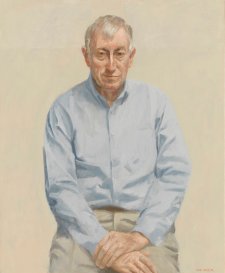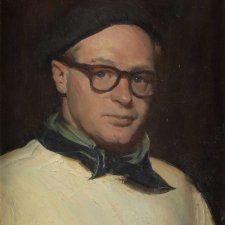- About us
- Support the Gallery
- Venue hire
- Publications
- Research library
- Organisation chart
- Employment
- Contact us
- Make a booking
- Onsite programs
- Online programs
- School visit information
- Learning resources
- Little Darlings
- Professional learning
This posthumously painted double portrait by Sir William Dargie captures the ebullience and confidence of aviators Sir Charles Kingsford Smith MC AFC (1897–1935) and Captain Charles Ulm (1898–1934). Famous for their record-breaking flights, the co-pilots made the first successful trans-Pacific flight from California to Brisbane in 1928. During the First World War, Kingsford Smith served in the Australian Imperial Force, the Australian Flying Corps and the Royal Flying Corps, and was awarded the Military Cross for bravery. Ulm, who at 16 had been among the first troops to land at Gallipoli, and later served on the Western Front, had returned to Sydney with a vision of establishing a commercial airline. He became Kingsford Smith’s business partner in 1927, and they founded the short-lived Australian National Airways in 1930. In 1934, Ulm went down in the sea between California and Hawaii; his body was never found. Kingsford Smith, too, disappeared, probably near the coast of Myanmar, on an attempt at the Britain–Australia record.
Gift of the Sydney Airports Corporation 2001
© Roger Dargie and Faye Dargie
The double portrait of Captain Charles Kingsford Smith and Captain Charles Ulm was painted by William Dargie in 1961 and measures 133.5 cm high by 108.8 cm wide.
The pair are presented against a brilliant blue sky with patches of white wispy cloud. Broad brushstrokes of light blue and pink give way to a greener bluish tint in the lower section of the background. The clouds descend into pale grey as the landscape blurs into the distance.
Bathed in sunlight, the men stand close together and are cropped at the hip. Captain Charles Ulm on our left, faces forward, half his body obscured by Sir Charles Kingsford Smith who stands in front, his body turned toward Ulm, side on.
Ulm’s direct gaze is forward to us. He has wavy brown hair cut shorter around his prominent ears and a warm rosy tanned complexion. The light from his right creates shadows on the left side of his clear broad forehead and delineates his straight nose, plump cheeks and double chin. His arched dark eyebrows, narrowed laughing eyes and parted lips open his cheery face into a wide smile.
Ulm wears a beige and green scarf wrapped around his neck and tucked into his aviator jump suit, unzipped to form a V. The one-piece suit is uniformly steely blue grey, a large pocket with a silver button and open upper flap is visible on his right chest. The baggy suit puckers at his waist and upper arm, which is bent at the elbow, and allows his right hand to rest on his hip. Cropped at the bottom edge of the painting, a brown strap is visible looped around the top of his index finger. Although Ulm's left arm is unseen, wrapped behind the figure of Kingsford Smith, the fingers and the thumb of that hand rest on Kingsford Smith's left shoulder.
Sir Charles Kingsford Smith looks out to the right of the portrait with a similarly tanned complexion to Ulm. His brown leather aviator helmet sits tight on his skull over his ears and clips together under his chin. His round glass goggles are raised above his eyes and held tight against his forehead. With his long oval face in three-quarter profile, a shadow plays on the left side of his face, accentuating his straight eyebrows, drooped eyelids and blue eyes. He has pronounced cheek bones and a long slightly hooked nose. He too is smiling with closed lips, with a slight curved crease around both corners of his mouth. Kingsford Smith wears a chocolate brown leather flying jacket, one side flaps open across his chest and is lined in a beige green sheepskin. At his waist his hands clasp a long slim white folded paper.
Audio description written and voiced by Annette Twyman, 2021
Sir William Dargie CBE (age 49 in 1961)
Sydney Airports Corporation (3 portraits)



On one level The Companion talks about the most famous and frontline Australians, but on another it tells us about ourselves.



Scientists tend to conjure up images of men in white coats in labs but this is just one stereotype in an evolving history of how we have perceived scientists, and how their profession has been understood over the years.



Sir William Dargie, painter and eight times winner of the Archibald Prize for portraiture, died in Melbourne on July 26, 2003, aged 91.